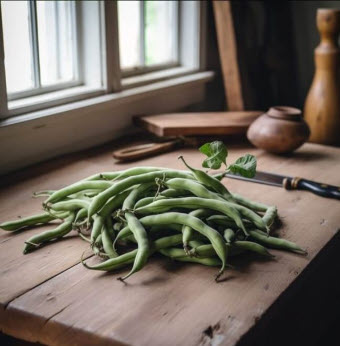Would you prefer to listen to a short podcast discussion about this article? Click on the audio below.
Broad beans, also known as fava beans, are a staple in many gardens due to their easy cultivation and delicious taste. These beans are a great source of protein, fibre, and other essential nutrients, making them a healthy addition to any diet. If you’re looking to grow your own beans you’re in luck – the UK climate is ideal for growing these plants.
In this article, we’ll cover everything you need to know about how to grow broad beans, from selecting the right variety and preparing the soil to planting, caring for, harvesting, and storing your beans. With the right knowledge and care, you’ll be rewarded with a bountiful harvest of tasty and nutritious beans that you can enjoy throughout the year!
Table of Contents
Introduction to Broad Beans
What Are Broad Beans?
Broad beans, also called fava beans, are an excellent addition to any vegetable garden. These beans are loved by many for their delicious taste and numerous health benefits. Broad beans grow in pods and come in different varieties, and depending on the type, they can grow up to 3 feet tall. They are very popular in the UK and are often found in traditional dishes such as mushy peas and fish and chips.
Benefits of Growing Broad Beans
Growing broad beans is not only a great way to enjoy fresh and healthy produce, but it also has benefits for the environment. Ther plants are nitrogen fixers, which means they can take nitrogen from the air and convert it into a form that can be used by plants, providing a natural source of fertilizer. Additionally, growing broad beans can attract beneficial insects to your garden, such as bees and ladybugs, which help pollinate other plants and eat harmful pests.
Selecting the Right Variety of Beans
Different Types
There are several different types of beans to choose from, including Aquadulce Claudia, The Sutton, and Super Aquadulce. Each variety has its own unique characteristics, such as size and flavour. The Aquadulce Claudia is one of the most popular types of bean in the UK and is known for its large pods and mild flavour.
Factors to Consider When Choosing the Right Variety
When selecting the right variety of beans, consider factors such as soil type, climate, and the size of your garden. Some varieties are better suited to warmer climates, while others can tolerate colder temperatures. Additionally, some varieties may be more suitable for container growing, while others are better for larger garden spaces.
Preparing the Soil
Soil Requirements
Bean plants prefer well-draining soil that is rich in organic matter. The soil should also have a pH level between 6.0 and 7.0. It’s essential to ensure that the soil is fertile enough to support the growth of the plants.
How to Prepare the Soil for Planting
To prepare the soil for planting, add organic matter such as compost or well-rotted manure to the soil. This will add essential nutrients to the soil and improve soil structure, making it easier for the plants to grow. Ensure that the soil is adequately drained and well-aerated. You can also add a balanced fertilizer to the soil, such as a 10-10-10 NPK fertilizer.
Planting Broad Beans
When to Plant
Broad beans are a cool-season crop and should be planted as early as possible to ensure that they have enough time to mature before the hot summer weather. In the UK, the beans should be planted in late autumn or early winter for a spring harvest or in spring for a summer harvest.
How to Plant
Sow the seeds directly into the soil about 2 inches deep and 8-10 inches apart. Water the soil well after planting, and keep it moist until the seeds germinate. Once the plants have sprouted, thin them out if necessary so that they are at least 6 inches apart. It’s also a good idea to mulch around the plants to help retain soil moisture.
Caring for Broad Beans
These beans are a great addition to any garden, and with proper care, they can thrive and produce a bountiful harvest. Here are some tips for caring for your broad beans:
Watering
Bean plants need regular watering, especially during dry spells. Water them deeply once or twice a week, making sure the soil is moist but not waterlogged. Avoid splashing water on the leaves to prevent the development of fungal diseases.
Fertilizing
Broad beans benefit from a balanced fertilizer, such as a 10-10-10 blend, applied before planting and again when the plants are about six inches tall. Avoid over-fertilizing, as it can lead to excessive vegetative growth and poor pod development.
Supporting Broad Beans
The plants can grow quite tall and benefit from staking or support. Use bamboo canes, twine, or netting to create a framework that will support the plants as they grow. Train the plants to grow up the support to reduce the risk of damage to the stems and pods.
Managing Weeds Around Broad Beans
Weeds can compete with broad beans for nutrients and water, so it’s important to keep the planting area weed-free. Use a hoe or hand-weeder to remove weeds regularly, being careful not to disturb the bean’s shallow roots.

Harvesting and Storing Your Beans
How to Determine When Your Beans Are Ready for Harvesting
Broad beans are ready to harvest when the pods are plump and have a slightly waxy texture. You can also check by gently squeezing the pods to feel the beans inside. If they feel firm, they are ready to be picked.
Best Practices for Harvesting
To avoid damaging the plants, use a pair of scissors or shears to cut the pods from the stem. Be careful not to cut into the plant or damage any nearby pods. Harvest the beans regularly to encourage continued production.
How to Store Harvested Broad Beans
Store freshly harvested beans in a paper bag or breathable container in the fridge. They will keep for a few days. To freeze, blanch the beans in boiling water for two to three minutes, then plunge them into cold water to stop the cooking process. Freeze in airtight containers for up to six months.
Common Problems and Pests
Common Diseases That Affect Broad Bean Plants
Broad beans are susceptible to diseases like rust, chocolate spot, and blight. To prevent these diseases, ensure good air circulation around the plants, avoid over-watering, and remove any diseased plant material promptly.
How to Identify and Control Pests on Your Bean Plants
Aphids, blackfly, and whitefly can be common pests on broad beans. Spray the plants with a strong blast of water to dislodge the insects, or use an insecticidal soap or oil spray. Avoid using broad-spectrum pesticides that kill beneficial insects like bees and ladybugs.
Tips for Growing Healthy and Productive Broad Beans
Important Do’s and Don’ts
– Do plant your beans in a sunny, well-drained spot in the garden.
– Don’t overwater or over-fertilize the plants.
– Do support the plants with stakes or netting to prevent damage.
– Don’t let weeds take over the planting area.
Expert Tips for Growing Broad Beans
– Choose a variety that is suited for your location and climate.
– Sow the seeds in the fall for an early crop the following year.
– Interplant with companion plants like garlic, onions, or chives to deter pests.
– Harvest young pods regularly to encourage continued production. Growing broad beans can be a fun and rewarding experience. By following the steps outlined in this article, you’ll be well on your way to producing a healthy crop of delicious beans. Remember to choose the right variety, prepare the soil, plant and care for your beans properly, and harvest and store them correctly. With a little patience and effort, you’ll be enjoying the fruits of your labour in no time!
FAQs
1. When is the best time to plant broad beans in the UK?
The best time to plant broad beans in the UK is usually between November and February. However, you can also plant them in the fall or early spring, depending on your location and the weather conditions.
2. How do I know when my beans are ready to harvest?
Broad beans are usually ready to harvest when the pods are fully developed and plump. You can also check by opening a pod and checking that the beans inside are firm and light green in colour.
3. What should I do if my beans are attacked by pests or diseases?
If your broad beans are attacked by pests or diseases, you should take prompt action to prevent them from spreading. This may include removing infected plants, treating the soil with fungicides or pesticides, or using natural remedies such as neem oil or garlic spray.
4. How long can I store my harvested beans?
Harvested broad beans can be stored for up to two weeks in the refrigerator. To store them for longer periods, you can blanch and freeze them in airtight containers for up to six months.
If you are keen on organic gardening, check out The Soil Association website
If you need any further information or assistance with this article, don’t hesitate to Contact Us



















